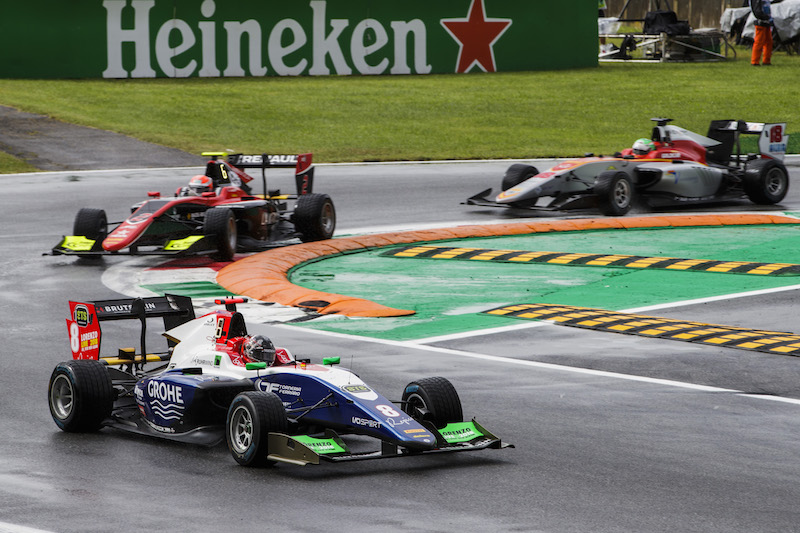
Photos: GP3 Series Media Service
The field of drivers taking part in the final GP3 season may not have been a star-studded future Formula 1 champion-filled grid that we’ll look back fondly on in a decade’s time, but it wasn’t short of talent and competition. There were numerous F1 juniors, and plenty of drivers who put themselves onto that radar.
As has been the case since the series’ inception in 2010, certain teams had a measurable edge, with ART Grand Prix making it eight teams title out of nine. It won the first five feature races this year, but had to contend with Trident and Campos Racing in the second half of the season.
Debutant MP Motorsport also performed well, with Dorian Boccolacci winning the first race at Paul Ricard, before being disqualified due to a minor fuel error. He was able to return to the top step two rounds later in Hungary, before graduating to Formula 2.
Jenzer was the only team to miss out on the podium, while Arden picked up two courtesy of Joey Mawson, but ultimately the worst of the six teams, struggling just as it did in 2010 to bookend its otherwise successful stint at this level. With performance differential between the teams, we attempt to look beyond the disparities and rank the top 10 drivers of the final year of GP3.
Key Percentage of team’s points scored (TP%), Qualifying average (QA), Feature race average points (R1P), Sprint race average points (R2P)
10.?Jake Hughes?ART Grand Prix?8th in standings (1 win, 1 fastest lap, 3 podiums)
TP% – 13%, QA – 7th (8th best on grid), R1P – 3.4 (9th best), R2P – 6 (4th best)

Considering his level of experience, Jake Hughes can be nothing but disappointed with how his return to GP3 panned out, as the worst of the four ART drivers – his storming drive from 13th to third in the first reversed-grid race of the season provinf to be a false dawn.
He regularly shone in the reverse-grid races, proving his wheel-to-wheel ability on numerous occasions, including beating Pedro Piquet to win at the Red Bull Ring after an overnight chassis change. But he struggled to string a strong set of results together, with his one-lap speed often letting him down, and issues out of his control are believed to at least have partly contributed to his poor season.
His dominant run in Asian Formula 3 car, winning all nine of the races he competed in (albeit against weaker opposition), and fourth place on his Macau Grand Prix return were good reminders of his class.
9.?Joey Mawson?Arden International 13th in standings (1 fastest lap, 2 podiums)
TP% – 84%, QA – 13th (17th best), R1P – 1.8 (14th best), R2P – 2.4 (14th best)
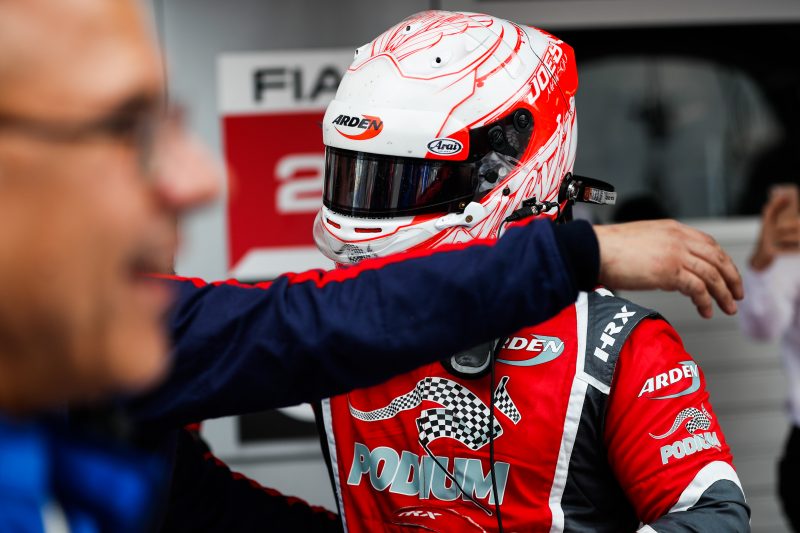
Mawson carried Arden’s slim hopes of success this year, contributing 84% of Arden’s points tally, and proving to have some of the best defensive skills on the grid.
With qualifying a particular struggle for the team, it was the reversed-grid races where Mawson shone brightest. He earned race two pole at Sochi, and looked set to take a maiden victory after providing a masterclass in defence driving. However the timing of the virtual safety car restart on the final lap robbed the Australian.
Mawson’s resolve has been impressive, keeping career momentum and his reputation growing despite circumstances leaving him with little in results.
8.?Giuliano Alesi?Trident 7th in standings (1 win, 1 fastest lap, 4 podiums)
TP% – 23%, QA – 6th (6th best), R1P – 6.6 (6th best), R2P – 5.4 (7th best)
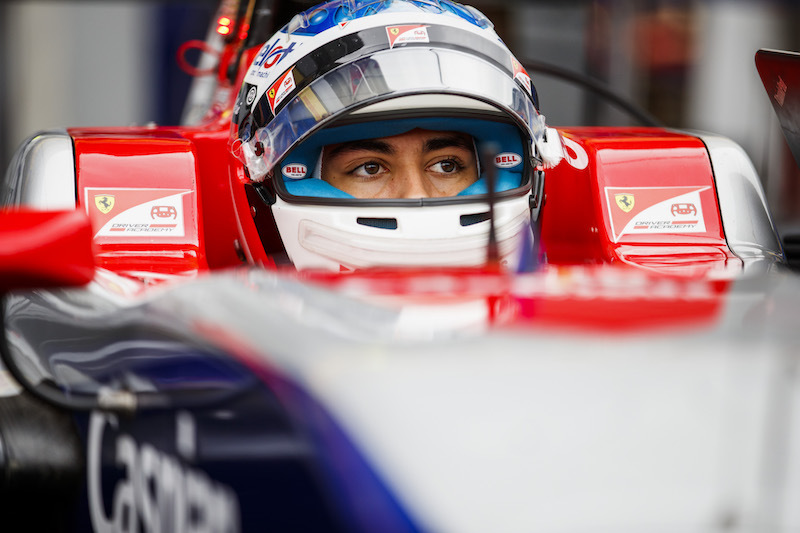
With three sprint race victories last year, Alesi headed into 2018 with a reputation. He had the challenge of proving he could be successful on Saturday as well as Sundays. It started with the status quo, with Alesi triumphing in a wet reversed-grid race at the Barcelona season opener, but he was able to achieve his first feature race podium a race later at Paul Ricard.
Unfortunately that would be the high point of his season, with his only two other podiums coming when he lost out on sprint race wins to his Trident team-mate Pedro Piquet at Silverstone and Monza. His first-corner clash with team-mate Ryan Tveter and then-Jenzer driver David Beckmann also cost him a likely podium at the Red Bull Ring.
It wasn’t the significant step he needed to demonstrate, but he still deservedly secured his 2019 F2 seat with Trident.
7.?Dorian Boccolacci?MP Motorsport?10th in standings (1 win, 1 pole, 1 podium)
TP% – 95% (before moving up to F2), QA – 6th (5th best), R1P – 5.0 (11th best), R2P – 5.8 (6th best)
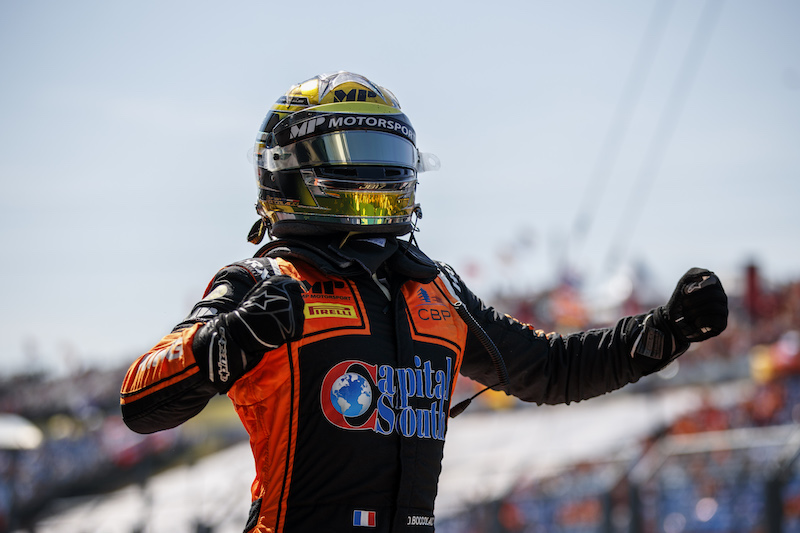
As previously mentioned, Boccolacci was stripped of his excellent maiden feature race win at Paul Ricard, which almost certainly cost him a place in the top eight of the championship, despite only completing a half-season.
He had the fifth best qualifying average, and was comfortably the leading MP driver at each event. For the second successive season, Boccolacci’s end of season points tally did him little justice, and he was importantly a driver who excelled in qualifying and the races.
His F2 graduation with MP was well earned, and hopefully he’ll hopefully get a proper shot in the championship next year.
6.?Pedro Piquet?Trident 6th in standings (2 wins, 1 fastest lap, 4 podiums)
TP% – 24%, QA – 9th (11th best), R1P – 5.1 (7th best), R2P – 6.7 (best on grid)

Piquet was one of the surprise stars of the season. Although his qualifying averages were behind his team-mates, he was often leading the charge on Sundays, replacing Alesi as the sprint race king by scoring more points in reversed grid races than any other driver.
The highlights included triumphing against Alesi at both Silverstone and Monza, and finishing second at Paul Ricard and the Red Bull Ring. Although a consistent scorer, his feature race pace now needs to improve, as despite being in the second best team behind ART, was rarely the driver leading the challenge against it.
5.?Callum Ilott?ART Grand Prix?3rd in standings (2 wins, 1 pole, 2 fastest laps, 7 podiums)
TP% – 26%, QA – 4th (4th best), R1P – 11.6 (5th best), R2P – 6.6 (2nd best)

Ilott began the season as many people’s title favourite, but ended the year a distant third in the drivers’ championship. It started well when he picked up his first win in the reverse-grid race at Paul Ricard, and followed it up a week later with a pole-to-win victory in Austria, while his team-mates Hubert and Mazepin collided – it meant he arrived at his home round in Silverstone with the championship lead.
This is where his challenge began to fail. He was outqualified by both Hubert and Mazepin for the next four consecutive rounds, meaning he was always on the back foot and usually failed to overturn that deficit in the races, as he failed to beat Hubert in any of the remaining feature races after his win in Austria.
There’s still a great deal of talent and potential in Ilott, but he was unable to show all of it this year, beyond his early-season flourish.
4.?Leonardo Pulcini?Campos Racing 4th in standings (2 wins, 2 poles, 2 fastest laps, 5 podiums)
TP% – 80%, QA – 4th (3rd best), R1P – 13.3 (3rd best), R2P – 3.1 (10th best)
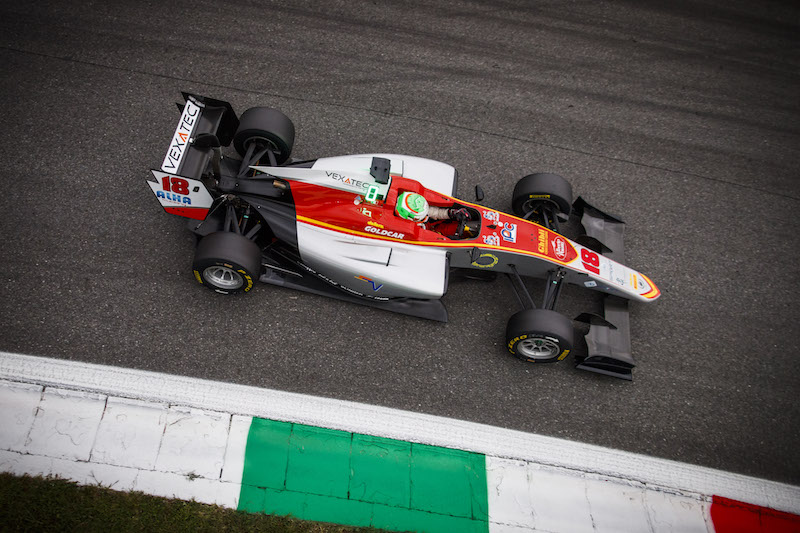
A good argument could be made that Pulcini deserves the number one spot on this list. He scored three times the amount of points of the previous most successful driver Campos has run in GP3 (Alex Palou in 2015). The majority of his success came in feature races, due to an excellent qualifying record. Barcelona was a false start: Pulcini took the first non-ART pole since Jake Hughes put DAMS on pole for the 2016 season-opener, but he fell to fourth on the opening lap.
By the end of the year, he’d perfected his feature race technique, winning from pole at Sochi, and expertly wrestling his second win of 2018 from title contender Nikita Mazepin in Abu Dhabi.
Unfortunately, his inconsistencies and mistakes prevented him from seriously challenging for the title. He knocked his front wing in Spain, qualified 12th at Spa, dropped out of fourth at Monza due to a gearbox issue, and his crash with David Beckmann and Anthoine Hubert in the season finale was just silly.
3.?David Beckmann?Jenzer/Trident?5th in standings (3 wins, 2 poles, 1 fastest lap, 4 podiums)
TP% – 46%/53%, QA – 8th (10th best), R1P – 11.6 (4th best), R2P – 2.8 (11th best)

Beckmann’s transformation once he switched from Jenzer to Trident was simply outstanding. He converted pole positions at Spa and Monza into two dominant feature race wins. He struggled to 15th in qualifying at Sochi, but recovered brilliantly to fifth in the feature race and then won the reverse-grid race, with a brilliant last-lap move on Mawson.
Second place at Abu Dhabi cemented him as the top scorer of the second half of 2018, and he may have ended his year with a podium had it not been for an over-ambitious Pulcini.
After a couple of difficult years in European Formula 3, Beckmann has put himself firmly back on the radars of F1 teams.
2.?Nikita Mazepin?ART Grand Prix?2nd in standings (4 wins, 1 pole, 5 fastest laps, 8 podiums)
TP% – 31%, QA – 3rd (2nd best), R1P – 15.6 (2nd best), R2P – 6.0 (3rd best)
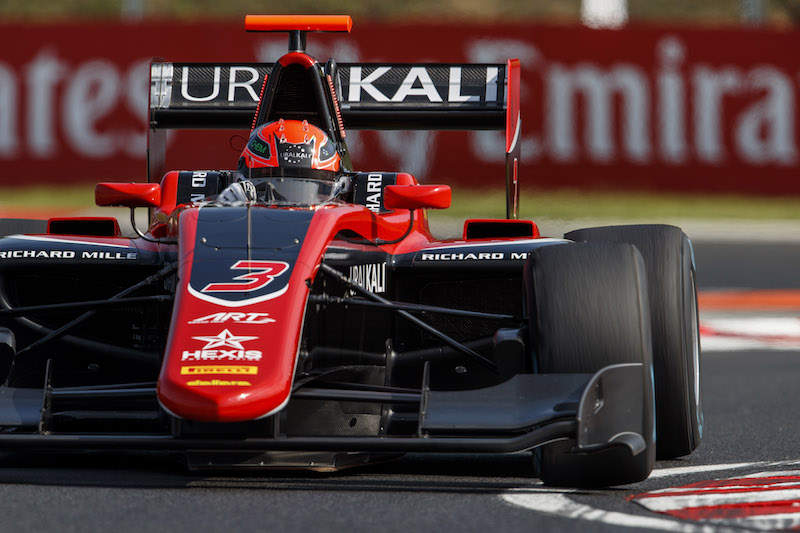
Mazepin was often the quickest driver on the grid, but a couple of major errors prevented him from taking the crown. The well-resourced Russian shocked everyone by dominating the first race of the year, and would go on to prove that was no fluke.
His first major misstep came at the Red Bull Ring, where he sent team-mate Hubert into a spin while recovering from an earlier wayward moment at Turn 1 after contact with Piquet. Other major errors included his huge crash at Turn 13 at Sochi and abusing track limits in the decisive race at Abu Dhabi.
Aside from that, Mazepin was just brilliant, and showed a real grit in wheel-to-wheel combat. He went from occasional Euro F3 points scorer to dominating GP3 races against some of the same competition, firmly justifying graduation to F2 with ART next year.
1.?Anthoine Hubert?ART Grand Prix?1st in standings (2 wins, 2 poles, 4 fastest laps, 11 podiums)
TP% – 33%, QA – 2nd (best on grid), R1P – 16.9 (best on grid), R2P – 6.0 (5th best)
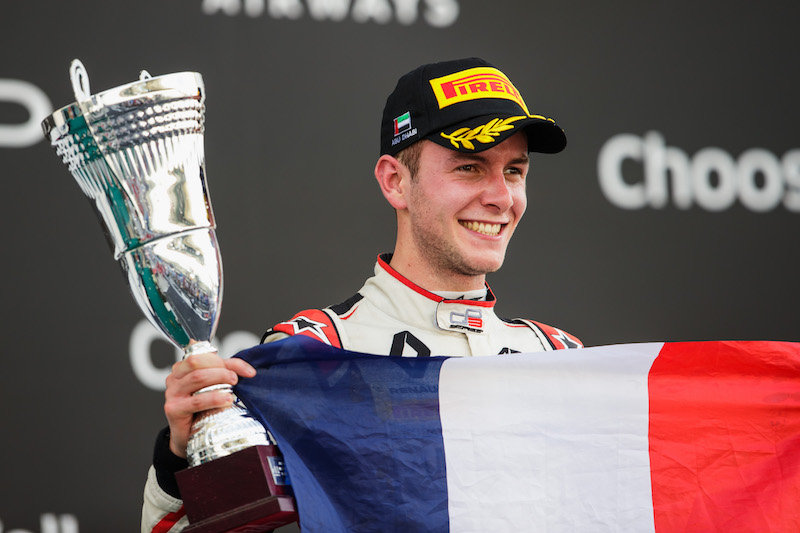
Could it really be anybody else? Hubert provided a masterclass in how to win a championship. He was consistently fast, and had it not been for Mazepin’s mistake at the Red Bull Ring, a small tyre pressure error at Monza and Pulcini’s squeeze in Abu Dhabi, Hubert would have scored points in every single race.
Not only was he fast and consistent (the best qualifying and race one average), but he was also uber confident in wheel-to-wheel battling. Never afraid to pull a move on his team-mates, which began with his excellent repass of Ilott at the opening round, Hubert showed excellent racecraft, avoiding incidents and rarely making a single error all year.
Of course he benefitted from a year of GP3 experience, but he did what the likes of Hughes, Jack Aitken, Nirei Fukuzumi and Marvin Kirchhofer were unable to do in their second years.
Just missing out…

Simo Laaksonen was a pleasant surprise, not achieving the highs of his Campos team-mate Leonardo Pulcini, but considering his relative lack of experience, he did an excellent job. His breakthrough result came in the wet opening race at Monza, where he charged from 14th to fourth. He capped his year with another excellent drive in the reverse-grid race at Abu Dhabi, coming through from ninth to third place to secure his maiden GP3 podium.
Trident’s Ryan Tveter failed to make a significant step in his second year in GP3, with a struggling start which included been involved in a collision with his team-mate Alesi and reverse-grid poleman Beckmann at the start of race two at the Red Bull Ring, eliminating the trio.?He recovered well a week later to pick up his first podium of 2018 at Silverstone. He added one more podium with second-place at Spa, and took fifth place from 11th on the grid in the final race at Abu Dhabi.
Alessio Lorandi would have likely made this top 10 list had he seen out the season. He had the seventh-best qualifying average, and finished third in the Austrian feature race despite racing with a broken collarbone. Lorandi graduated to F2, and Niko Kari?would later join him. While Kari’s GP3 campaign was marred with incidents, his MP team-mate Richard Verschoor?was superb in his four-event cameo, the highlight being his charge to third place and his maiden podium at Sochi.
Tatiana Calderon enjoyed her best GP3 season scoring her first point at Budapest before achieving six-points finishes in the last eight races, but her breakthrough came too late and lacked a top-five result. Her team-mate Juan Manuel Correa?did a solid job all year, frequently securing a front-row reverse-grid place. Although he was unable to convert any of these positions into a podium, his fourth place at a wet Barcelona was Jenzer’s best result of the year. His brilliant Abu Dhabi defensive masterclass should have handed him a top-two finish, but a five-second penalty for VSC speeding dropped him to sixth. Consider Correa the 11th entry on this list.
*Average qualifying results have been adjusted to discount worst result, as a way of eliminating outliers.